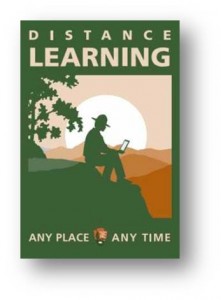![]()
This week I met with Dale Carpenter, the National Park Service’s (NPS) Distance Learning (DL) Program Manager, to collect some thoughts about the current and future state of DL in government.
Dale’s unique perspective includes experience from years of service in both the public and private sector.
What does a day look like in the life of a Distance Learning program manager?
When I came on board last April, I didn’t really know what to expect in terms of the learning programs or capabilities of the National Park Service. I envisioned the pace of work would be like canoeing over calm, glassy waters, but instead it’s more like level III whitewater rapids! There are so many great ideas for improving learning, but with limited resources and staff, prioritization is paramount.
I quickly learned that our workforce is extremely motivated and capable. We are pretty savvy with webinars but lack internal capacity to produce self-paced eLearning courses that are a big part of most DL programs. We were also just skimming the surface on newer approaches to learning via technology.
My day to day activities vary, but they generally include meetings with local and central office staff on how to make better use of our capabilities, phone calls to connect with internal customers, research on possible acquisitions or new technologies, and the regular management activities that you’d expect from any supervisor. I’m also making time to connect with various stakeholder groups out in the field.
What are you particularly excited about in terms of bringing DL to the workforce?
Too often, we see how technology is misapplied in some way, and I get excited about finding ways to use technology to make learning easier or more effective. The Common Learning Portal (CLP) project is a prime example. Right now, it’s difficult for employees to locate training opportunities scattered across more than 20 websites and systems: our customers were asking, “how can we make this better?”
We’re now working together with stakeholder groups across the service to create a common system that shares training information, learning resources, and networking opportunities. We’re also looking at how to integrate other technologies, such as mobile learning, into our learning ecosystem. Many of our field employees have mobile access on the job, and to be able to deliver training to them when they need it is a powerful idea. That’s not to say we’re abandoning formal training programs, only that we’re acknowledging that there are many informal learning opportunities out there as well.
 Our logo says it all: Distance Learning-Any Place Any Time. Our vision and our challenge is to reach employees in some of the most remote (and beautiful) locations in the nation. We’re really excited about technologies that allow employees to participate in learning opportunities despite limited connectivity.
Our logo says it all: Distance Learning-Any Place Any Time. Our vision and our challenge is to reach employees in some of the most remote (and beautiful) locations in the nation. We’re really excited about technologies that allow employees to participate in learning opportunities despite limited connectivity.
What are your top challenges?
In reality, I think technical challenges may be easier to address than organizational ones.
We’re a very decentralized organization, and that works out well for us in many circumstances. However, finding success in this type of organization is much different than navigating the command structure I was familiar with from my work with the military. Our team is much more of a support element than an authority, and we’re seeing success from building a network of partners and allies. I see internal marketing as a big part of our future success.
What does the future look like for DL in government?
DL has earned a bad reputation, and rightfully so. When you take a classroom environment and strip away key interactions with instructors and peers, you’re already isolating the learner. You can’t simply take classroom content and put in online: the challenge is really in the redesign.
Regardless of the technology, if we don’t have a good, interactive design that takes into account the needs and experience of the learner, we can’t produce high quality products and a well-trained workforce. The challenge is to get past the traditional “click next” mode of training and find ways to make the experience engaging and relevant. I think we’ll see a lot more out of applied learning technologies (even simple ones like smartphone cameras), and I’m looking forward to helping customers match systems with design.
Any closing thoughts or advice?
For other managers, get to know the needs of your customers, and by that I mean the end user, whether they’re next door or 1,000 miles away. We often use surveys, but sometimes the only way to really find something out is to talk with customers directly to determine what kind of capability they need. Don’t try to captain the ship from behind your desk.
For users of DL, please be patient with us…the best is yet to come.
Dave Barton is part of the GovLoop Featured Blogger program, where we feature blog posts by government voices from all across the country (and world!). To see more Featured Blogger posts, click here.





I would like to know how you can help me (us), in establishing my own GovLoop Mobile Learning
Portal?
I used to work at the National Park Service back in 1989, long before I got involved in online learning. It’s good to see them making these great advances.